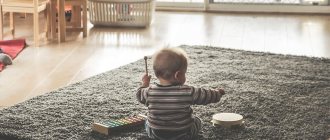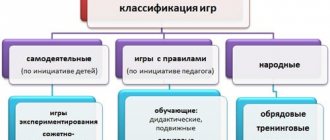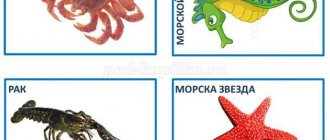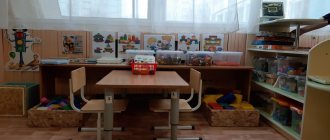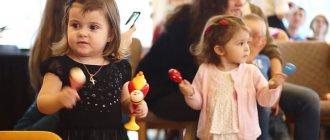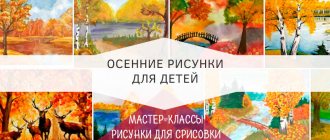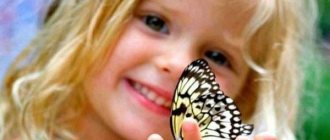The concept and essence of artistic and aesthetic development of preschool children
Definition 1
Artistic and aesthetic development is the process of developing the prerequisites for the value-semantic understanding and perception of works of art, the formation of an aesthetic attitude to the surrounding world and elementary ideas about types of art, the realization of one’s own creative potential.
Artistic and aesthetic activity by its nature is a specific activity in which each child is given the opportunity to reveal his own potential, show his abilities through a specific product of activity (crafts, drawings, applications, etc.).
Note 1
The concept of preschool education sets clear tasks for educators and teachers; the solution provides for the artistic and aesthetic development of preschool children, as well as the development of creativity in them, which is necessary for future life activities.
Are you an expert in this subject area? We invite you to become the author of the Directory Working Conditions
In accordance with the Concept of Preschool Education, a number of requirements are imposed on educators, namely the presence of certain competencies necessary for the comprehensive artistic and aesthetic development of preschool children:
- Ability to establish working relationships with each child based on mutual trust and respect.
- Respectful attitude towards the personality of each student.
- Respect the choices and needs of each student.
In accordance with the Federal State Educational Standard for Preschool Education, artistic and aesthetic activities aimed at the development of a child within the preschool educational institution include:
- Visual activities (drawing, modeling, applique).
- Musical activity, including musical perception (listening to musical works, getting to know musical instruments, learning to play musical instruments, etc.).
- Fiction (listening to works of fiction, reading them, discussing them, etc.).
Recommendations for teachers and educators
Recommendations for the moral and aesthetic education of preschoolers include a number of methods and principles:
- Aesthetics of the environment (live plants, furniture, color scheme for playrooms, cleanliness and order).
- Independent artistic activity (classes in free creativity using decorative and applied arts).
- Classes with a teacher (development of tastes and ideals under the supervision and sensitive guidance of a mentor).
There are some features of aesthetic education of preschool children in preschool educational institutions. Unlike the home environment, creative activity takes place among peers and under the guidance of a competent mentor. This motivates the child to do everything better so that he is praised and distinguished from the rest. If at home a child often gives up at the first failure, then in kindergarten, looking at the example of other children, he will look for ways to cope with the task. Therefore, creative and aesthetic activities should be carried out precisely in preschool educational institutions.
To do this, the teacher must clearly understand what creativity is and what competencies and skills the child should acquire as a result.
Indicators of creative activity (according to I. Lerner):
- the ability to use old knowledge in a new situation without outside help;
- the ability to find and apply new functions of an already known object;
- the ability to see problems in a standard situation;
- the ability to combine previously known methods into new ones.
The teacher should encourage the child for showing independence, and in no case scold if the children, for example, start drawing a bouquet instead of one flower. What is important is a relaxed atmosphere and some relaxation of discipline - let the preschoolers talk, go to the window or stand with toys. Then the aesthetic education of preschoolers will be carried out with joy and inspiration for the child.
Tasks of artistic and aesthetic education of children of different age groups of preschool educational institutions
Tasks of artistic and aesthetic education of children of the younger group of preschool educational institutions:
Finished works on a similar topic
Course work Artistic and aesthetic development of preschool children 480 ₽ Abstract Artistic and aesthetic development of preschool children 220 ₽ Test work Artistic and aesthetic development of preschool children 190 ₽
Receive completed work or specialist advice on your educational project Find out the cost
- Carrying out comprehensive preparation for the perception of artistic works of art.
- Encouraging children to visit cultural and aesthetic places: theater, cinema, museum, exhibition, etc.
- Introduction to decorative activities.
- Familiarization with musical and artistic genres.
- Promoting the development of musical abilities.
- Formation of interest in artistic activities, familiarization with different drawing techniques.
- A retelling of famous works based on illustrations and pictures.
The main tasks of artistic and aesthetic education of children in the middle and senior groups of preschool educational institutions:
- Forming children's interest in various types of art, introducing them to the aesthetic perception of art.
- Introducing children to the professions of an artist, singer, composer, performer, etc.
- Introduction to architecture.
- Consolidating the knowledge acquired in the junior group about books, book illustrations, etc.
- Continued development of interest in visual arts by enriching children’s understanding of the arts
- Continue to develop interest in appliqué, modeling, drawing, etc. Getting to know new techniques.
- Learn to recognize songs while listening to the melody, perform dance moves and play non-musical instruments.
Meaning
From the first days of life, children begin to explore the world around them. Kids are drawn to bright toys and look at colorful pictures. Art, even the simplest, is a source of joyful emotions.
At the same time, children appreciate everything beautiful. They analyze the shape of things, their sound (musical instruments). The emotional response to everything attractive occurs unconsciously. Therefore, in early preschool age, aesthetic education is closely related to sensory culture.
Since the baby’s physical abilities are still limited, he studies all objects with his eyes and hands. The combination of the lines of things and their colors allows the child to appreciate their attractiveness.
A feature of aesthetic education is that the child experiences joyful emotions from meeting a beautiful object. It evokes a range of positive experiences in a child’s soul. This contributes to better development of the child.
Tips for parents
Aesthetic education of preschoolers is a long process. It is precisely described in the federal standard. The Federal State Educational Standard can be used not only by teachers, but also by parents when raising children. According to him, aesthetic education begins with the birth of a child.
It happens according to the following plan:
| Child's age | Parents' actions |
| Infant (up to 1 year) | They allow them to explore various objects and encourage the baby’s cognitive activities. They regularly read children's poems and sing songs. |
| Early preschool age (from 1 year to 3 years) | Let children become familiar with dynamic toys. They are introduced to independent study of art objects. They encourage me to look at and evaluate the pictures. |
| From 3 years to 8 | They introduce role-playing games and conduct research and educational activities. Objects of the surrounding world are studied and evaluated. They not only listen to musical works, but also learn to understand their meaning and respond to a cheerful or sad melody. |
Parents should introduce their children to beauty constantly. For example, during a walk you can draw your child’s attention to a beautiful flower or the bright plumage of a bird. They admire the cat's movements and look at the floating clouds.
Aesthetic education should not end outside the garden walls. It is necessary to teach the child to cleanliness. It is important that he cleans up his toys, because order is beauty.
It is worth noting that if a child’s aesthetic tastes differ from his parents, no attempt is made to change them. It is important to support the baby. When blue or black is his favorite color, there is no need to force him to paint it red. With age, these preferences may change.
The aesthetic education of preschoolers largely depends on the child’s parents. This is not only an introduction to the world of art, but also regular joint creative gatherings. If a child can not only appreciate, but also create objects of art, then this indicates the highest point in the development of aesthetic taste.
Working with parents
Aesthetic and artistic education of preschool children is a complex process that requires interaction between parents and teachers. If they have different methods of influence or legal representatives do not pay enough attention to this area of education, then the child will not receive the necessary knowledge.
Often parents do not understand how to instill aesthetic taste in their children. The teacher must help them understand the essence of the educational process. To do this, you can conduct consultations or master classes.
Creative tasks
Various competitions are often held in preschool institutions. For example, you need to make a birdhouse or make a craft from natural material. To do this, the teacher communicates with parents and explains the goals and objectives of this event.
It is important to convey to adults that they must do any thing together with their children. This will not only improve the climate in the family, but will also develop the child’s creative abilities.
Principles of organizing the competition:
- The teacher develops a plan. It includes the duration of the event, the rating system, and work requirements.
- Competently draws up instructions for parents to follow.
No one should be forced to participate. Parents and children themselves must take the initiative. In order for as many families as possible to participate, the teacher must initially interest the children. For example, during a walk, the teacher tells them about birds and what kind of houses they have.
After this, the group shows examples of birdhouses. Then he says that everyone can make such a house themselves. Interested children persuade their parents to participate in the competition.
Master classes
Not all adults have developed creative abilities. Therefore, the teacher conducts a master class on creating some kind of craft at least once a month. It could be a doll made from scraps, an interesting drawing, or a craft made from scrap materials.
The teacher chooses the topic independently, taking into account the age of the children. This is necessary so that parents can incorporate the experience gained into their child’s education at home.
Consultations
Consultation on the need for aesthetic education should take place regularly. In order to enhance diversified development, teachers introduce parents to exhibitions, concerts, and events held in their locality.
For example, if a local museum is hosting an exhibition of folk art, you can make a bright poster and hang it on the doors of the group. The information sheet indicates the venue, opening hours and other necessary details.
It is necessary to explain to parents that learning should not end after leaving the kindergarten to go home. Consultations are held on various topics. With the arrival of autumn, they help parents teach their children to see the beauty in nature. For example, while going home you can collect a bouquet of yellow leaves,
Psychological aspect
During their education, children develop an aesthetic taste. It manifests itself in the appreciation of works of art, when examining paintings. At the same time, you can admire the beauty of the world in everyday life. Children see aesthetics in the objects and clothes around them.
Aesthetic education of preschoolers is a long process, in which the main role is given to education. In this case, the teacher influences, first of all, the child’s psychology. Children are read books (certain works for each age group) and allowed to listen to music.
To experience the beauty of the literary word, read books by such authors as:
- Chukovsky K. I.
- Marshak S. Ya.
- Mikhalkov S. V.
The works of the following composers help to understand the beauty of music:
- Kabalevsky D. B.
- Tchaikovsky P. I.
All this affects children psychologically. They do not expend physical effort to listen to works. Only the brain works. If books bring children pleasure, then this shapes their aesthetic taste.
